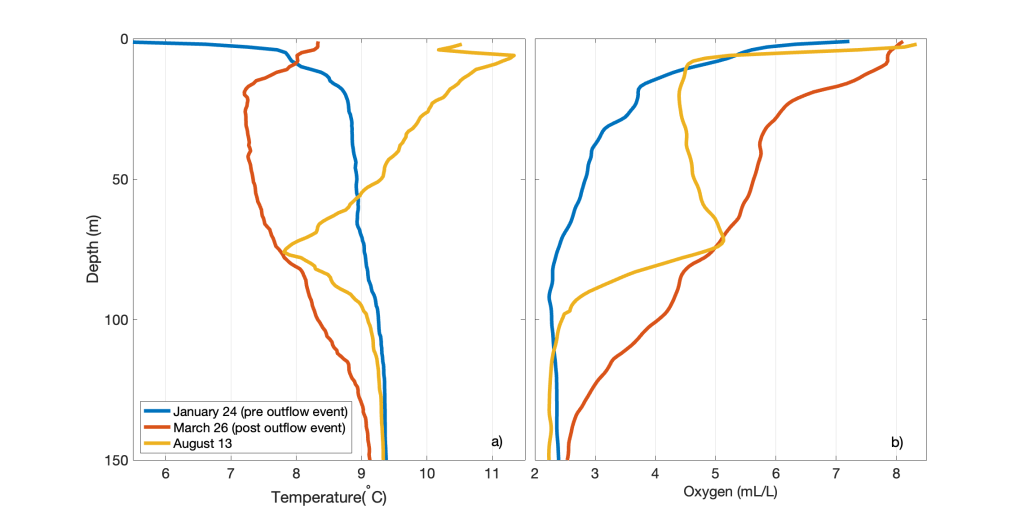
Cold Arctic outflow winds cool and reoxygenate coastal waters in Bute Inlet, British Columbia
– By Jennifer Jackson, Jody Klymak, Keith Holmes, Wiley Evans, Alex Hare, Charles Hannah, Bill Floyd, Laura Bianucci, Di Wan–
Anthropogenic climate change has led to the warming (Johnson et Lumpkin, 2022) and loss of oxygen (Breitburg et al., 2018) in the world’s oceans. In British Columbia, temperature and oxygen data have been collected in fjords since 1951 (Pickard, 1961). Between 1951 and 2020, deep (Jackson et al., 2021) and intermediate (Jackson et al., 2022) waters warmed and lost oxygen. Despite these long-term trends of warming and deoxygenation, there are regional mechanisms in some areas of the coastal waters that cause cooling and reventilation; identifying and understanding these mechanisms and their spatial variability is important to assess the complexity of change in the coastal oceans.
Arctic outflow winds are defined as the transport of cold, dry air from the continent to the coast through a mountain pass (Overland and Walter, 1981). Given the complexity of the British Columbia coastline, the impact of Arctic outflow winds is variable, and inlets that have an unimpeded connection to the continent can transport less modified, colder air to the coast (Bakri et al., 2017). Bute Inlet, within the traditional territory of the Homalco Nation (Figure 1), is an example, where the valley between the continent and the coast is not blocked by mountains (MacNeil, 1974). Bute Inlet is a fjord that is about 80 km long and up to 700 m deep, with one sill that is about 355 m deep (Pickard, 1961).

Temperature, salinity and oxygen data have been collected at eight stations in Bute Inlet since 1951 by the University of British Columbia (1951 to 1987), Fisheries and Oceans Canada (1989 to 2014), and the Hakai Institute (2017 to present). Atmospheric data have been collected on the continental plateau at Tatlayoko Lake since 1928. In total, more than 800 oceanographic profiles have been collected in Bute Inlet and these data are available online at www.cioos.ca. For this research, we use air temperature to identify an Arctic outflow event in February 2019, and use oceanographic observations and a 2-D model to investigate the impact of the Arctic outflow winds on Bute Inlet.
The Arctic outflow event lasted from February 1 to 15, 2019, with daily average air temperatures at Tatlayoko Lake ranging from -5 to -24°C. Oceanographic data were collected on January 24 and March 26, 2019. Between those dates, the upper ~100 m of the water column cooled by more than 1.5°C and gained more than 3 mL/L of oxygen (Figure 2). A model simulation forced by realistic atmospheric conditions (winds spun up over 1 day that reached a maximum of 15 m/s for 4 days) recreated this cooling and reoxygenation, confirming that Arctic outflow events can cause mixing to 100 m in Bute Inlet.

Future studies are to extend this study in space in time, specifically i) to examine what other British Columbia inlets are impacted by Arctic outflow winds and ii) to examine how Arctic outflow winds have been impacted by climate change. In addition, an important area of future research is to determine how the marine ecosystem is impacted by Arctic outflow winds.
Jennifer Jackson is a research scientist in at the Hakai Institute who currently studies warming and deoxygenation in coastal British Columbia waters. She has also studied water mass formation and the impact of ocean warming on sea ice melt in the Arctic Ocean and the impact of the Agulhas Current on South African coastal waters. Jennifer co-founded the British Columbia Environmental Film Festival in 2021.
Twitter: @JenJack79805343, @HakaiInstitute
References
Bakri, T., Jackson, P., & Doherty, F. (2017). A synoptic climatology of strong along-channel winds on the coast of British Columbia, Canada. International Journal of Climatology, 37, 2398-2412, doi:10.1002/joc.4853.
Breitburg, D., L.A. Levin, A. Oschlies, M. Gregoire, F.P. Chavez,V. Garcon, D. Gilbert, D. Gutierrez, K. Isensee, G.S. Jacinto, K.E. Limburg, I. Montes, S.W.A. Naqvi, G.C. Pitcher, N.N. Rabalais, M.R. Roman, K.A. Rose, B.A. Seibel, M. Telszewski, M. Yasuhara, and J. Zhang. 2018. Declining oxygen in the global ocean and coastal waters. Science 359, doi:10.1126/science.aam7240
Jackson, J.M., Bianucci, L., Hannah, C.G., Carmack, E.C., & Barrette, J. (2021). Deep waters in British Columbia mainland fjords show rapid warming and deoxygenation from 1951 to 2020. Geophysical Research Letters, 48, e2020GL091094, doi: 10.1029/2020GL091094.
Jackson, J.M., Johannessen, S., Del Bel Belluz, J., Hunt, B.P.V., and Hannah, C.G. (2022). Identification of a seasonal subsurface oxygen minimum in Rivers Inlet, British Columbia. Estuaries and Coasts, doi:10.1007/s12237-021-00999-y
Johnson, G. C. and R. L. Lumpkin, Eds., 2022: Global Oceans [in “State of the Climate in 2021”]. Bull. Amer. Meteor. Soc., 103 (8), S143–S191, doi: 10.1175/ BAMS-D-22-0072.1.
MacNeil, M.R. (1974). The mid-depth temperature minimum in B.C. inlets (T). The University of British Columbia. https://open.library.ubc.ca/collections/ubctheses/831/items/1.0053207.
Overland, J.E., & Walter, B.A. (1981). Gap winds in the Strait of Juan de Fuca. Monthly Weather Review, 109, 2221-2233. doi: 10.1175/1520-0493(1981)109<2221:GWITSO>2.0.CO;2
Pickard, G.L. (1961). Oceanographic features of inlets in the British Columbia mainland coast. Journal of the Fisheries Research Board of Canada, 18(6), 908-999. doi: 10.1139/f61062
bute inlet, coastal water, hakai institute, jennifer jackson
